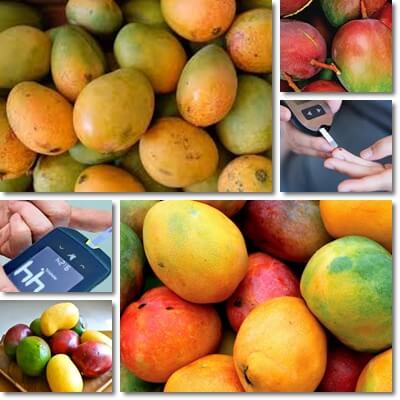Plenty of diabetic patients can eat mango, but in very small amounts and preferably not every day. The fruit is an important source of carbohydrates, most of which are simple sugars and thus brings a significant contribution to the dietary requirements of the diabetic patient. Depending on the severity of the metabolic condition, particularly insulin sensitivity, which dictates the individual tolerance of the diabetic patient to sugar in fruits and other foods, the allowed intake of mango may differ from person to person, but remains limited to very small amounts nonetheless.
For example, some diabetic patients can eat mango in very small amounts, occasionally and no more than one serving a day, but others might not respond well to the fruit at all and are better off avoiding it altogether. For those than can eat mango with diabetes, it helps to spread the one serving over the course of an entire day, eat it after a light protein or low carbohydrate meal, not before, and go for a walk after having the fruit to help reduce possible side effects and better manage blood sugar levels.

Does mango have a lot of sugar? Quite a lot, actually. There are an estimated of 13.66 g of sugar in 100 g of ripe mango, all varieties included. This is almost as much as grapes, but surprisingly less than watermelon and pineapple, two fruits that are considered not that good for diabetes. Eating too much at once or too often can definitely cause spikes in blood sugar levels. But if you enjoy the fruit in small amounts, preferably after a light protein, low carbohydrate meal, and no more than one serving a day, then it is possible to experience a steady rise in blood sugar levels and no side effects.
One of the benefits of mango for diabetes is its fiber content: 1.6 g of dietary fiber/100 g of fruit. Dietary fiber is indigestible plant material that goes unchanged through the gastrointestinal tract. While there are attempts at digesting fiber, the body is unsuccessful because it lacks the intestinal bacteria to break it down into simpler components. However, the fiber does slow down digestion and the emptying of the stomach and further tempers the absorption of nutrients such as vitamins and sugar at the level of the intestinal tract. And by slowing down digestion, the fruit contributes to a slower, steadier rise in blood sugar levels, a major benefit for diabetics.
Mango glycemic index (GI): low to moderate
The glycemic index is a scale that measures how fast the digestible carbohydrates from plant foods are broken down into simple sugars and absorbed into the bloodstream, contributing to blood sugar levels. The effects of the carbohydrates in plant foods are compared to the effects of pure glucose. Below 55 is a low glycemic index. Between 55-69 is a moderate glycemic index. Between 70-100 is a high glycemic index. Generally diabetics are advised to choose fruits with a low glycemic index because the sugar in them is absorbed slower and contributes to a steadier rise in blood sugar levels, which is a good thing for the condition.

But different varieties of the same fruit and different levels of ripeness within the same fruit variety can generate differences in glycemic index values. What this means is that the riper the mango, the higher the glycemic index. Similarly, the more unripe the mango, the lower the glycemic index. This is because unripe fruit have more indigestible fibers (hence their tougher pulp and the reason they cause stomach discomfort and diarrhea in many people). As the fruit ripens, a lot of the indigestible fibers ripen too and turn into sugars (this is also why the pulp softens and the fruit becomes sweeter). See Unripe vs Ripe Fruit.
Ripe mango glycemic index is 55, which can be classified as low to moderate. This is a general estimate which means it’s likely not perfectly accurate for all mangoes, irrespective of variety or stage of ripeness. But it gives one a good general idea of what to expect of the fruit. Generally speaking, the fruit is a relatively good choice of fruit to include in a diabetic diet, as long as there is a good management of the condition and a good general tolerance to eating fruits in limited amounts. The lower the glycemic index of a fruit, the steadier the sugars obtained from it following digestion are absorbed into the bloodstream and the higher the likelihood of more stable blood sugar levels.
However, know that some mangoes may have a higher GI than this, usually in the lower half of the moderate glycemic index scale, especially very ripe fruits and particularly sweet varieties. At the same time, the less sweet, less ripe fruit may potentially have a slightly lover GI because of the lower sugar, higher fiber content. Bottom line is: when planning your meals and determining the total carbohydrate and sugar content of your food, leave room for some variation.
General glycemic index of ripe mango, all varieties (red, orange, yellow, green): 55.
Unripe mango glycemic index: low, possibly lower than in the ripe and overripe fruit.
Dried mango glycemic index: moderate to high, usually over 69 if the fruit is also sweetened.
Dried mango and diabetes
Dried fruits are a sensitive issue for diabetics because a lot of them have added sugars which amp up sugar content and raise glycemic index. Traditionally dried mango, no added sugars, will have more carbs, sugar, calories and a higher glycemic index than the fresh fruit, but can still be included in a diabetic in limited amounts. It’s recommended to see a dietitian for a personalized eating plan as well as plan ahead for eating the dried (unsweetened) version of the fruit so you don’t exceed your recommended daily intake of carbohydrates and sugar.
100 g of dried mango with added sugars (sweetened) provides 319 kcal, more than 5 times the calories in the fresh fruit. And most of the calories come from carbohydrates. The same amount also provides 78.58 g of total carbohydrates, of which 66.27 g are simple sugars and only 2.4 g are made of indigestible fiber. So the sweetened variety has almost 5 times the sugar of the fresh fruit. It’s safe to say that it will have a high glycemic index and raise blood sugar levels fast, which is bad for diabetes. And since it’s hard to limit intake to maybe 1-2 small pieces of the dried fruit, chances are a lot of people will overeat which is a source of side effects for the condition.
Mango calories: 60 kcal/100 g
The energetic value of food also matters with diabetes because the higher the intake of high-calorie foods, the more pregnant the weight gain. The main complication and often causative factor for diabetes is weight gain. Weight gain accentuates insulin resistance and reduces tolerance to certain foods that are important sources of digestible carbohydrates and simple sugars, including fruits. Fortunately, fresh mango has a moderately low calorie content and can be included in a diabetic diet safely as long as the condition is well managed with diet, exercise and proper treatment and the diet is centered around the specific nutritional requirements of the metabolic condition.
So is it safe for diabetics to eat mango?
Mango is one of those fruits most diabetics can eat with their condition, but shouldn’t really eat too much of or too often. The fresh fruit is safest for most diabetics, but only in small amounts, not every day and preferably no more than one serving a day. The dried, unsweetened variety may be consumed by some diabetics, but in even smaller amounts than the fresh fruit and only after consulting their doctor. However, the dried, sweetened fruit is not good for diabetes because of its high carb, high sugar, high GI and high energetic value.
At the same time, not all diabetics can eat the fruit. If you feel sick after eating mango, then it may not be good for you individually and you might be better off choosing other, more low glycemic fruits. It could help to reduce intake to even smaller amounts, revise the rest of your diet (maybe you are eating too much carbs or sugar a day and the mango comes as a surplus), spread intake over the course of a day, have fruit after a light protein meal and exercise lightly afterwards.
Benefits of eating mango for diabetes
Overall, considering its nutritional value, the benefits of mango for diabetes are:
1) Doesn’t raise blood sugar levels, provided intake is limited to small amounts.
2) Minor benefits for blood pressure thanks to small amounts of potassium and magnesium.
3) Benefits for blood cholesterol from vitamin C which has antioxidant and anti-inflammatory activity.
4) Benefits for wound healing from vitamin C.
5) Benefits for skin thanks to B vitamins, good amounts of vitamin E and pro-vitamin A antioxidants (beta-carotene and small amounts of lutein and zeaxanthin). Pro-vitamin A antioxidants further hold benefits for eyesight, an important aspect of diabetic health.
6) Good energetic value and fiber content, helping with weight management.
Conclusion
Is mango good for diabetics? Yes, it can be, but only if consumed in small amounts, occasionally, preferably no more than one serving a day and, if needed, the intake spread over the course of an entire day. Intake must also be compliant with the diabetic patient’s individual nutritional requirements and the dietary restrictions of their condition. Some diabetics may eat more of the fruit, others less and some might not be able to enjoy the fruit at all and feel sick if they have even the smallest amounts, in which case, other fruits may be considered.

